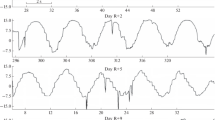Summary
On a space mission in March 1992 a set of experiments were performed aimed at clarifying the interaction between visual, proprioceptive and vestibular inputs to the equilibrium system. Using the VESTA goggle facility from the European Space Agency we investigated the effect of pure neck receptor stimulation on eye position as measured by the flash afterimage method and on perception of a head-fixed luminous line in space. Space vestibular adaptation processes were measured by rotating pattern perception during prescribed head movements. It was found that static ocular counterrotation does not occur under micro gravity conditions. This result suggests that the neck receptors apparently do not contribute to a measurable extent. The subjective orientation of a vertical line was perceived correctly inflight. Obviously neck receptors on the perception level can fully substitute for the ineffective equilibrium organs of the inner ear within less than 4 days. The rotating pattern perception during different head motion patterns is not influenced by the absence of a gravity reference.
Similar content being viewed by others
Abbreviations
- OCR:
-
ocular counterrotation
- VOR:
-
vestibulo-ocular reflex
References
Baumgarten RJ von (1986) European vestibular experiments on the Spacelab-1 mission. I. Overview. Exp Brain Res 64:239–246
Baumgarten RJ von (1987) General remarks on the role of the vestibular system in weightlessness. Arch Otorhinolaryngol 244:135–142
Baumgarten RJ von (1987) Biomedizinische Experimente im Spacelab unter besonderer Berücksichtigung der Versuche am Gleichgewichtsorgan. Physiol Akt 3:149–166
Baumgarten RJ von, Benson A, Berthoz A, Bles W, Brandt T, Brenske A, Clarke A, Dichgans, Eggertsberger R, Jürgens K, Kass J, Krafczyk S, Probst T, Scherer H, Thümler R, Vieville T, Vogel H, Wetzig J (1986) European experiments on the vestibular system during the Spacelab D-1 mission. In: Sahm PR, Jansen R, Keller MH (eds) Ergebnisse der Deutschen Spacelab D-1 Mission. Proceedings des Symposiums, Norderney, 1986. DFVLR, Cologne, pp 477–490.
Baumgarten RJ von, Kass J, Vogel H, Wetzig J (1989) Influence of proprioceptive information on space orientation on the ground and in orbital weightlessness. Adv Space Res 9:223–230
Berthoz A, Brandt T, Dichgans J, Probst T, Bruczek W, Vieville T (1986) European vestibular experiments on the Spacelab-1 mission. V. Contribution of the otoliths to the vertical vestibulo-ocular reflex. Exp Brain Res 64:272–278
Bischof N (1974) Optic-vestibular orientation to the vertical. In: Kornhuber HH (ed) Handbook of sensory physiology, VI/2. Vestibular system, part 2. Psychophysics, applied aspects and general interpretations. Springer, Berlin Heidelberg New York
Bles W, de Graaf B (1991) Ocular rotation and perception of the horizontal under static tilt conditions in patients without labyrinthine function. Acta Otolaryngol (Stockh) 111:456–462
Collewijn H, Van der Steen J, Ferman L, Jansen TC (1985) Human ocular counterroll: assessment of static and dynamic properties from electromagnetic scleral coil recordings. Exp Brain Res 59:185–196
Diamond SG, Markham CH (1983) Ocular counterrolling as an indicator of vestibular otolith function. Neurology 33:1460–1469
Diamond SG, Markham CH (1988) Ocular torsion in upright and tilted positions during hypo- and hypergravity of parabolic flight. Aviat Space Environ Med 59:1158–1162
Dichgans J, Bizzi E, Morasso P, Tagliasco V (1973) Mechanism of recovery of ocular stabilization during active eyehead turning following bilateral labyrinthectomy. Pflügers Arch 33: R77
Ebenholtz SM (1970) Perception of the vertical with body tilt in the median plane. J Exp Psychol 83:1–6
European Space Agency (1990) Spacelab and Eureca life sciences experiment facilities. European Space Agency, Paris, p 39
Fischer MH (1927) Messende Untersuchungen über die Gegenrollung der Augen und die Lokalisation der scheinbaren Vertikalen bei seitlicher Neigung (des Kopfes, des Stammes und des Gesamtkörpers). I. Mitteilung. Neigungen his 40 Grad. Grafes Arch Clin Exp Ophthalmol 118:633–680
Guedry FE jr (1974) Psychophysics of vestibular sensation. In: Kornhuber HH (ed) Handbook of sensory physiology: Springer, Berlin Heidelberg New York
Hain TC, Buettner UW (1990) Static roll and the vestibuloocular reflex (VOR) Exp Brain Res 82:463–471
Hofstetter K, Baumgarten RJ von, Kass JR (1987) Optokinetic and vestibular stimulation during parabolic flight. In: Pletser V, Gonfalone A, Frimout D (eds) Summary report: microgravity experiments during parabolic flights of KC-135 aircraft. ESTEC working paper 1510. European Space Research and Technology Center, Noordwijk
Hofstetter-Degen K (1988) Eine psychophysiche Untersuchung zur visuell-vestibulären Interaktion: Beeinflussung der Objektbewegungswahrnehmung durch gleichzeitige Eigenbewegung. Thesis, University of Mainz
Hofstetter-Degen K, Wetzig J, Kass J, Reiser M (1991) Subjective luminous line perception under changing g-load and body positions in parabolic flight. Appl Micrograv Technol 4:45–47
Kass JR, Baumgarten RJ von, Benson A, Berthoz A, Brandt T, Brand U, Bruzek W, Dichgans J, Probst T, Scherer H, Vieville T, Vogel H, Wetzig J (1984) The European vestibular experiments in Spacelab-1. Adv Space Res 4:3–9
Kass JR, Bruzek W, Probst T, Thümler R, Vieville T, Vogel H (1986) European vestibular experiments on the Spacelab-1 mission. II. Experimental equipment and methods. Exp Brain Res 64:247–254
Kass JR, Vogel H, Baumgarten RJ von (1987) Neck receptor stimulation in 0- and 1-g. In: Hunt (ed) Proceedings of the 3rd European Symposium on Life Sciences Research in Space, Graz, Austria, 14–18 Sept. 1987; ESA SP-271, Dec. 1987. Paris, European Space Agency, pp 233–236
Krejcova H, Highstein S, Cohen B (1971) Labyrinthine and extra-labyrinthine effects on ocular counter-rolling. Acta Otolaryngol 72:165–171
Mittelstaedt H (1992) Somatic versus vestibular gravity reception in man. Ann NY Acad Sci 656:124–139
Schöne H (1962) Über den Einfluss der Schwerkraft auf die Augenrollung und auf die Wahrnehmung der Lage im Raum. Z Vergl Physiol 46:57–87
Teiwes W, Clarke AH, Scherer H (1993) Dynamic analysis of ocular torsion in parabolic flight using video-oculography. Acta Astronautica (in press)
Tschermak A, Schubert G (1931) Über die Vertikalorientierung im Rotatorium und im Flugzeuge. Pflügers Arch 228:234–257
Wetzig J, Reiser M, Baumgarten RJ von (1991) Transition from self tilt to object tilt during maintained lateral tilt in parabolic flight. Acta Astronautica 23:63–67
Author information
Authors and Affiliations
Rights and permissions
About this article
Cite this article
Hofstetter-Degen, K., Wetzig, J. & von Baumgarten, R. Oculovestibular interactions under microgravity. Clin Investig 71, 749–756 (1993). https://doi.org/10.1007/BF00209730
Received:
Revised:
Accepted:
Issue Date:
DOI: https://doi.org/10.1007/BF00209730



